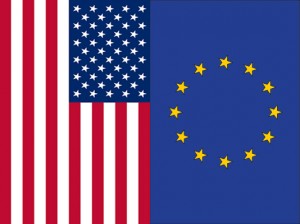 The European Union has published its report on the 12th round of Transatlantic Trade and Investment (TTIP) negotiations, held in Brussels Februiary 22-26. The full document is available here. The section reporting on the intellectual property negotiation (pp. 15-16) follows:
The European Union has published its report on the 12th round of Transatlantic Trade and Investment (TTIP) negotiations, held in Brussels Februiary 22-26. The full document is available here. The section reporting on the intellectual property negotiation (pp. 15-16) follows:
3.5 Intellectual property rights, including Geographical Indications
Given the efficiency of the respective systems, the EU’s intention in this area of negotiations is not to strive towards harmonisation but to identify issues of common interest where we can address divergences. The latest discussions continued to explore what elements a TTIP IPR chapter could include.
The IPR discussions took place over 2 full days. The US presented two IPR text proposals. One was a reaction to the EU initial text on IP related international agreements, which shares many common points with our text. The other was as a first draft on common provisions, broadly in line with the equivalent text in TPP. The two sides discussed how to increase the pace of IPR negotiations in the next couple of rounds. Other sections where discussions are well advanced are customs enforcement and cooperation.
Regarding copyright and trade secrets the parties exchanged updates on the respective domestic legislative processes. Similarly, on international IPR agreements, both US and EU provided the state of play regarding ratification of the Marrakesh Treaty on Access to Published Works for the Visually Impaired and the Beijing Treaty on Audiovisual Performances.
On civil enforcement and technical protection measures/digital rights’ management, the US presented a comparative analysis between the relevant chapters of TPP and recent EU FTAs (CETA and Vietnam) and stressed the similarity of approach between the two sides on most provisions.
On customs enforcement, the US presented a newly adopted Trade Facilitation and Trade Enforcement Act, which contains positive elements allowing for increased cooperation and exchange of information with third countries.
On trade secrets, the EU presented the key elements of the text resulting from the agreement between Council and European Parliament on what should constitute the future Trade Secrets Directive and the US reported on progress on their equivalent draft bill.
For the EU, the future section on cooperation should reflect, to a large extent, what is already being done today, namely by the Transatlantic IPR Working Group.
Regarding the future section on agreed principles, it could be inspired by recent EU communications and strategy papers, as well as equivalent US documents. It should address different (and opposing interests and sensitivities) in a balanced manner and include SME relevant elements.
On geographical indications, discussions focussed on the preparation of an intersessional discussion prior to the next round.




